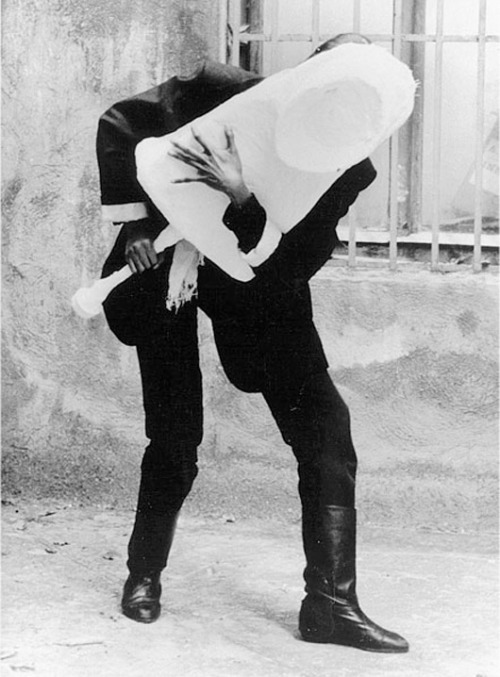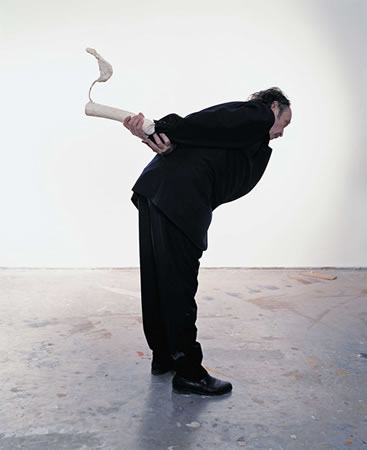
Lisa de Cohen with Adaptive, ca 1983
Franz West (16 February 1947 – 25 July 2012) was an Austrian artist.
West's artwork is typically made out of plaster, papier-mâché, wire, polyester, aluminium and other, ordinary materials. He started to produce paintings, but then turned to collages, sculptures, portable sculptures called "Adaptives" or "Fitting Pieces", environments and furniture – "welded metal chairs and divans, some minimally padded and upholstered in raw linen." For his early sculptures, West often covered ordinary objects -- bottles, machine parts, pieces of furniture and other, unidentifiable things -- with gauze and plaster, producing "lumpy, grungy, dirty-white objects".
http://en.wikipedia.org/wiki/Franz_West
Victor Misiano with Franz West's Labstück, 1991
Wrapping pieces of wood and cardboard and lengths of wire with gauze, coating it in plaster or papier mâché and painting the whole thing white, West made sculptures that the audience was meant to pick up, manipulate, examine at close range, hang on an arm or around the neck, or even stick one's face into. The shapes are abstract. But often, part of the sculpture suggests a handle — a direct visual invitation to audience participation. Silently it says, Touch me, hold me.
Other shapes appear designed to fit around the neck, under the arm or on other embraceable parts of the body. Or, they echo bodily orifices. (Can a sculpture have a belly button?) A glass bottle at the end of a long stick, both embedded in lumpy papier mâché, looks like a ritual implement meant to be passed around in some primitive religious ceremony.
These materials also evoke the damaged condition art holds in contemporary life. Like a cast made for a broken limb, white plaster and gauze result in sculptures bound in a medical dressing.
West calls these sculptures “Passstücke” -- originally translated as “fitting pieces” (passende Stücke) but now referred to as “adaptives.” In biology, adaptation is a structure or form modified to fit a changing environment. West's touch-me sculptures attempted the same for art's new circumstance.
http://latimesblogs.latimes.com/culturemonster/2009/03/franz-west-lacm.html
 A museum visitor models an Adaptive by West at the Museum for Modern Art in Frankfurt, Germany.
A museum visitor models an Adaptive by West at the Museum for Modern Art in Frankfurt, Germany. Elaine A. King: Few contemporary artists recognize the power of humor and farce, yet both resound through your work. You came of age while the Viennese Actionists were active, between 1960 and ’71. However, you rejected the transgressive performances, naked bodies, destructiveness, and violence of Hermann Nitsch, Otto Mühl, and Günther Brus. Why did you explore another avenue?
Franz West: The Actionists are all approximately 10 years older than me. I think that Actionism in its most brutal form was a reaction to the Nazi period, which I did not directly witness or experience. That period held no direct relevance for me beyond historical information. Perhaps my mother’s dental practice played a vitally influential role in shaping my attitude and aesthetic. She had her office in a room of our home, and I was filled with horror at the organic, decomposing materials in that medical space. I preferred to look into the future, which I saw as being optimistic. The forerunners of Pop art became known here in Vienna at that time, and art with a connection to daily life and to color was important.
EAK: Often when people discuss your work they reference the Austrian scholars Freud and Wittgenstein.
FW: Yes, they and their work are relevant in the sense that it was de rigueur for a young artist at that time to adopt their way of thinking; this resulted in a particular prevailing mood from which one worked. That’s how their ideas influenced my thinking.
http://www.sculpture.org/documents/scmag09/june_09/west/west.shtml
Paßstücke, 2007
Take the Paßstücke sculptures (usually translated as ‘Fitting Pieces’, ‘Adaptables’ or ‘Adaptives’), which West has been producing since 1974. Most of them begin with a found object, some discarded item, which he covers with a coat of plaster. This is then morphed into weird protrusions and extensions, so that the final work retains some of the familiarity of the original object it encloses, but is at the same time strange and alien. The Paßstücke are displayed on makeshift plinths, often with a sign explicitly encouraging viewers to pick them up and adopt any pose they feel might be appropriate to the form of the sculpture. Although the biomorphic shapes of the pieces look as if they were made to fit snugly into the folds and curves of a human body, they never do. You can try and stick them under your arm or between your legs, you can press them against your neck or stomach but the Paßstücke simply will not fit: you always end up uncomfortably contorted in a vain attempt to accommodate it - like one of Empedocles’ Ur-creatures trying to integrate a reluctant extra limb into your autonomy. The encounter with the sculpture ends up as pure slapstick.
Jan Verwoert
http://www.frieze.com/issue/article/adaptation/



No comments:
Post a Comment